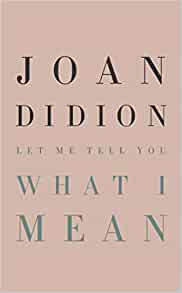Books |
Joan Didion: Let Me Tell You What I Mean
By
Published: Feb 20, 2022
Category:
Memoir
Joan Didion died on December 23, 2021. Sanctification was instant, and not surprising — Didion was an icon for discerning readers, feminists, and those who discovered her more recently in her grief memoirs, The Year of Magical Thinking and Blue Nights, and a documentary, Joan Didion: The Center Will Not Hold.
“Let Me Tell You What I Mean,” the paperback edition of a dozen pieces she wrote from 1968 to 2000, was published a short month after her death.
These pieces are fascinating. And often astonishing, because they reveal a Didion many readers wouldn’t recognize. To quote the Times, the tone of her writing was “levelheaded yet ambitious.” We get “levelheaded.” The news flash is “ambitious.” We think of Didion as a woman in a nondescript sweater, standing against a wall: the journalist as wallflower, seeing all, saying nothing. It’s easy to miss that persona as a strategy. Of course she was ambitious — all successful writers are. Of course she wasn’t a saint — like the best writers, she couldn’t not reveal her flaws. What she could do, very consciously, is create a persona, a shorthand performance for public consumption.
There are two excellent reasons to read these pieces. One is that each captures a moment and is so smart and tart you’ll want to underline something on almost every page. The other is for the personal sharing, which both supports and undercuts the Didion myth. [For the paperback, click here. For the Kindle edition, click here.]
Surprise! The opening essay, “Alicia and the Underground Press,” is positive about these counter-cultural papers of the hippie/Vietnam era. They reveal, she writes, “the inability of all of us to speak to one another in any direct way, the failure of American newspapers to ‘get through.'” To their credit, “When a writer for an underground paper approves or disapproves of something, he says so, quite often in lieu of who, what, where, when, how… To think that these papers are read for ‘facts’ is to misapprehend their appeal. It is the genius of these papers that they talk directly to their readers.” Just as she would.
There’s a cutting account of a Gamblers Anonymous meeting: “I had not heard so many revelations of a certain kind since I used to fall into conversations on Greyhound buses under the misapprehension that it was a good way to learn about life.” Nancy Reagan is “a woman who seems to be playing out some middle-class American woman’s daydream, circa 1948.” And the “genius” of Martha Stewart, in a piece written years before Stewart was jailed: She presented herself “not as a Superwoman but as Everywoman… getting out of the house with a vengeance, and on your own terms.”
“On Being Unchosen by the College of One’s Choice” is the most personally revealing of these pieces. It’s set in 1952, when Stanford rejects her. Her father “shrugged and offered me a drink.” But she’s inconsolable. She has an “old bottle of codeine-and Empirin.” She considers swallowing all the pills. Instead, she goes to Berkeley, and in “Telling Stories,” she’s admitted to Mark Schorer’s writing workshop. She’s terrified. She wears an old raincoat to class, the better to be invisible. But she never doesn’t go.
It’s “Last Words,” her assessment of Ernest Hemingway, that’s closest to a literary revelation. She analyzes the first 126 words of “A Farewell to Arms.” She goes on to write about the loss of his powers and the injustices to work he never planned to publish, but in those first few pages, she all but announces that his style was the best. She wrote that in 1998, when she was well along in a career that mirrored his style. Ironic, that a woman would be his literary heir.


